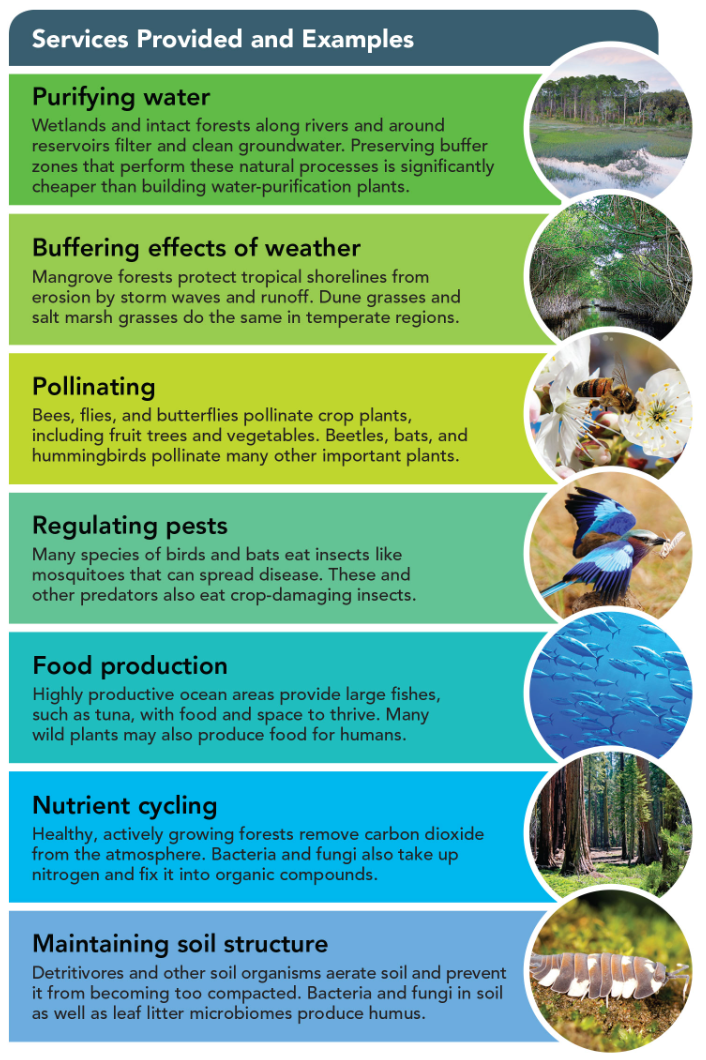biology ch 5 and 6
Chapter 5 Lesson 1
Ecologists study populations by examining their geographic range, growth rate, density and distribution, and age structure.
The places a population lives make up its geographic range, which can vary enormously in size, depending on the species.
A population increases or decreases depending on how many individuals are added or removed from it.
Birthrate, death rate, and the rate at which individuals enter or leave a population all affect population growth.
- increase when birthrate is higher than the death rate
- stays the same if birthrate equals the death rate
- decreases if the death rate is higher than the birthrate
population density - number of individuals per unit area
- can have different densities based on populations even in the same environment
population distribution - describes the way individuals are spaced out across their range
- random - occurs when the location of an individual in a population is independent of other individuals
- uniformed - results when individuals compete with each other for space or other resources
- clumped - helps animals avoid predators
age structure - the number of males and females of each age in a population
- researchers need to know the ages of an organism’s population to fully understand it
- important because most plants and animals cannot reproduce until they reach a certain age
immigration - movement of individuals into an area occupied by an existing population
- population could increase if individuals move its range from elsewhere
emigration - movement of individuals out of an area
- population could decrease if individuals move out of the population range
- local food shortages or lack of another limiting resource can also cause emigration
exponential growth - growth pattern in which the individuals in a population reproduce at a constant rate
- Each generation contains more individuals than the generation before it
- Under ideal conditions with unlimited resources, a population will increase exponentially. This means that the larger the population gets, the faster it grows.
- When a population doubles (ex. two cells every 20 min, after 60 min, there’s 2 x 2 x 2 cells or 2^3; after another hour there’s 2^6, then 2^9, etc.) it results in a J curve. A J curve rises slowly at first, then rises faster and faster if nothing interferes (population becomes larger and larger, faster and faster)
logistic growth - growth pattern in which a population’s growth slows and then stops following a period of exponential growth
Goes in an S shaped curve
What changes in a population’s growth rate produce a logistic curve? A population increases when more organisms are added to it, such as by birth, than leave the population, such as by dying. Thus, population growth may slow for several reasons and growth may slow if the birthrate decreases.
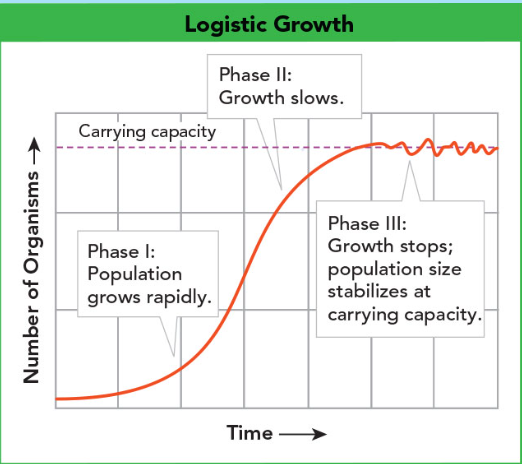
Phase 1: Population Grows Rapidly - After a short time, the population begins to grow exponentially. During this phase, resources are unlimited, so few individuals die, and many offspring are produced, so both the population size and the rate of growth increase more and more rapidly
Phase 2: Growth Slows Down - In real-world populations, exponential growth does not continue for long. At some point, the rate of population growth begins to slow down due to a variety of limiting factors such as competition for resources. This does not mean that the population size decreases; it still increases, but the rate of growth slows down, so the population size increases more slowly.
Phase 3: Growth Stops - At some point, the rate of population growth drops to zero, meaning that the size of the population levels off. Under some conditions, the population will remain at or near this size indefinitely.
carrying capacity - largest number of individuals of a particular species that a particular environment can support
- Once a population reaches the carrying capacity of its environment, a variety of biotic and abiotic external factors affect the population in ways that stabilize it at that size.
Chapter 5 Lesson 2
competition - when populations become crowded, individuals compete for food, water, space, sunlight, and other potentially limiting resources; can decrease birthrates, increase death rates, or both; is dependent because the more individuals that are present, the sooner they use up the available resources; occurs among members of different species (members of different species attempt to use similar or overlapping resources that are limited, which is a major force behind evolutionary change)
limiting factor - factor that causes population growth to decrease
- A limiting nutrient is a specific example of a more general ecological concept called a limiting factor.
- Limiting factors are either biotic or abiotic environmental factors that affect members of the population. Acting separately or together, limiting factors determine the carrying capacity of an environment for a species.
- Limiting factors keep most populations in their natural habitat at a population size somewhere between extinction and overrunning the ecosystem.
- Ecological limiting factors produce the pressures of natural selection that stand at the heart of Darwin’s evolutionary theory.
density-dependent limiting factor - limiting factor that depends on population density
- do not strongly affect small, scattered populations
- include competition, stress from overcrowding, parasitism, disease, predation, and herbivory
parasitism and disease - dependent because the denser the host population, the more easily parasites can spread from one host to another
stress from overcrowding - some species fight amongst themselves, some cause stress which weakens the body’s ability to resist disease; can cause females to neglect, kill or eat their own offspring in some species; lowers birthrates, raises death rates, or both; increases rates of emigration
predator-prey relationships - ex. between wolves and moose: when wolves have enough to eat, the population increases, so wolves kill more moose than are born; moose death rate rises higher than birthrate so moose population decreases; when moose population decreases then wolves begin to starve; starvation raises the wolves’ death rate and lowers their birthrate so the wolf population decreases; the moose death rate drops and cycle repeats
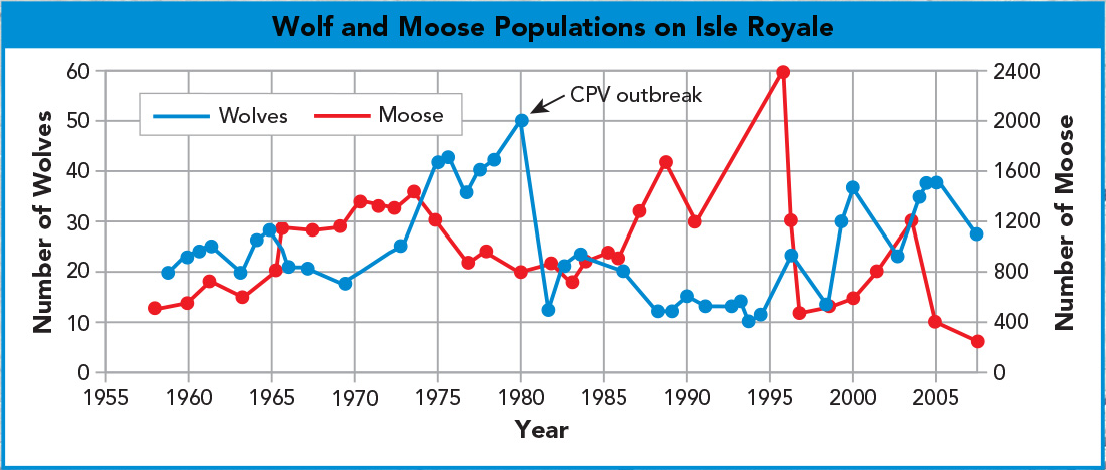
herbivore effects - populations of herbivores and plants cycle up and down (herbivores are plants’ predators); when moose populations eat large amounts of balsam fir, the population of the plant drops so moose may suffer from lack of food
humans as predators - human activity limits populations in some situations; some populations with lower birthrates can be negatively affected while populations with larger birthrates may not be affected at all
density-independent limiting factor - limiting factor that affects all populations in similar ways, regardless of the population density
- environmental extremes like weather extremes (hurricanes, droughts, floods) and natural disasters (wildfires) can act as density-independent limiting factors - a population may crash in response to these
- after crashing, the population may quickly build up again or may stay low
- storms can nearly extinguish local populations of some species; waves from hurricanes can devastate coral reefs; extremes of hot or cold weather no matter how sparse or dense a population is; prolonged environmental changes like droughts cause severe declines in population sizes
- if affected populations don’t recover, it can affect ecosystem stability
true density independence? - some effects of density-independent factors vary with population density; cold winter with heavy snowfall can cover plants that animals eat, making it difficult for them to find food (if they can’t emigrate then they could die from starvation); effects of bad weather on large, dense populations are usually greater than small populations because there’s less competition so each organism can have more food
controlling introduced species - artificial density-independent control measures (hunting) can offer temporary solutions but are very expensive; when some species are released, their original population increases dramatically and can threaten local species
limiting factors don’t always stay the same - temperature and rainfall can change if climate changes, available space for feeding and other activities; human activities divide natural environments into small pieces, causing carrying capacities to be much smaller; if carrying capacity falls low enough, populations can be wiped out, leading to species extinction
Chapter 5 Lesson 3
human populations increase, remain the same, or decrease due to the same factors that affect population growth of other species; in some countries, population growth is increasing, others are decreasing, and some are constant
the rate of human population increase changed over time - used to grow slowly (food was hard to find, predators and disease were common, causing high death rate so families had many children to ensure that some could survive
exponential human population growth - countries became more developed so food supplies became more reliable, leading to rapid human population growth; birthrates remained high so the combination of lower death rates and high birthrates led to exponential growth
predictions by Malthus - exponential growth cannot continue forever so competition (war), limited resources (famine), and parasitism (disease) should regulate human competition
world population growth slows - exponential growth of global human population continued until the second half of the twentieth century, reached a peak around 1959, then decreased sharply for a couple of years before rising again; exponential growth slowly decreasing since the mid 1960s and global human population continued to increase through this period; decrease in growth rate means population is growing more slowly now than it used to 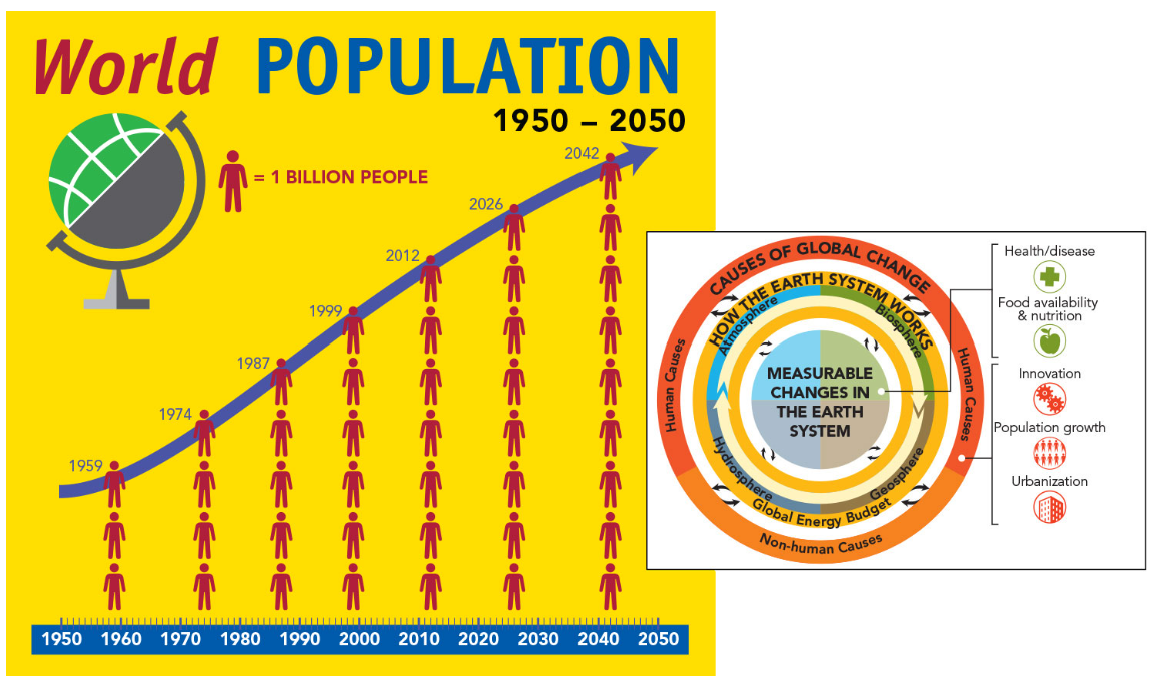
demography - scientific study of human populations
- examines characteristics of human populations and attempts to explain how those populations will change over time; can identify social and economic factors that affect human population growth
- Birthrates, death rates, and the age structure of a population help predict why some countries have high growth rates while other countries’ populations increase more slowly
demographic transition - change in a population from high birth and death rates to low birth and death rates
- dramatic change from high birthrates and death rates to low birthrates and death rates
- human societies had equally high birthrates and death rates for most of history, but in the United States, Japan and most of Europe, population growth slowed dramatically
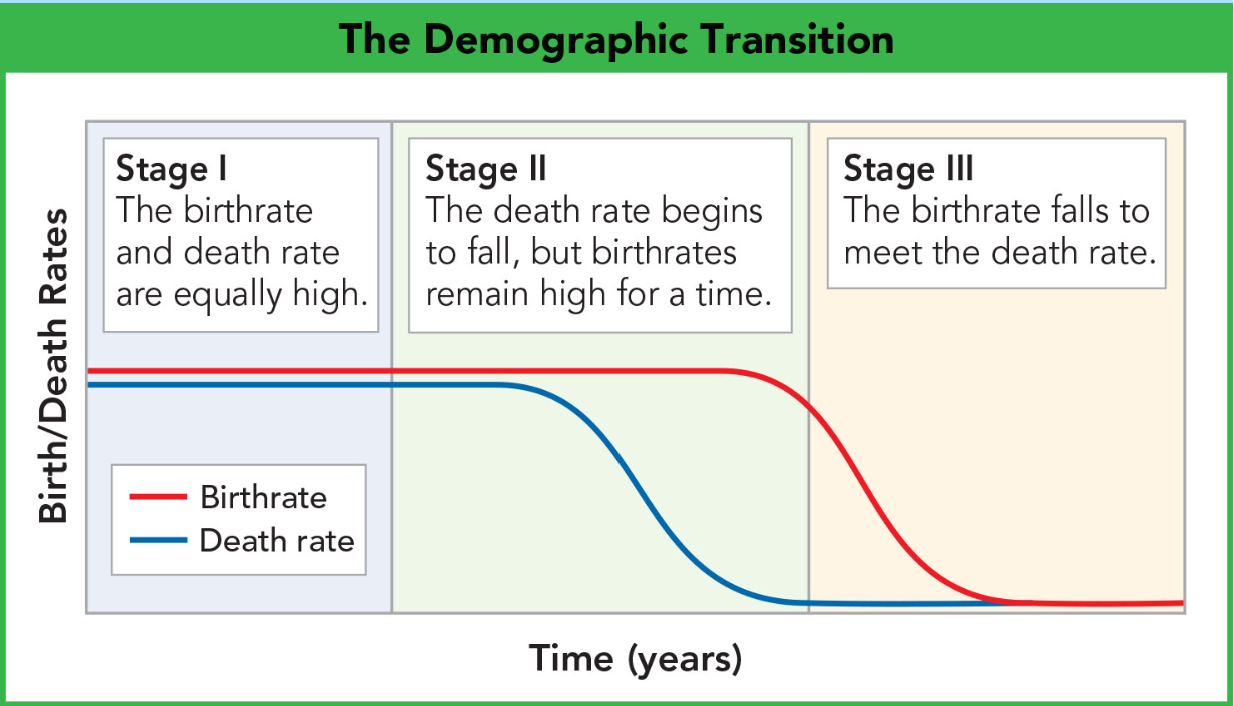
J-shaped exponential growth curve may be changing into a logistic growth curve, but global human population is still growing
age structure and population growth - age structure diagrams compare the number of people in different age categories; age structure of a population reveals how fast a population is growing—greater percentage of young people means a growing population, greater percentage of older people indicate a shrinking population 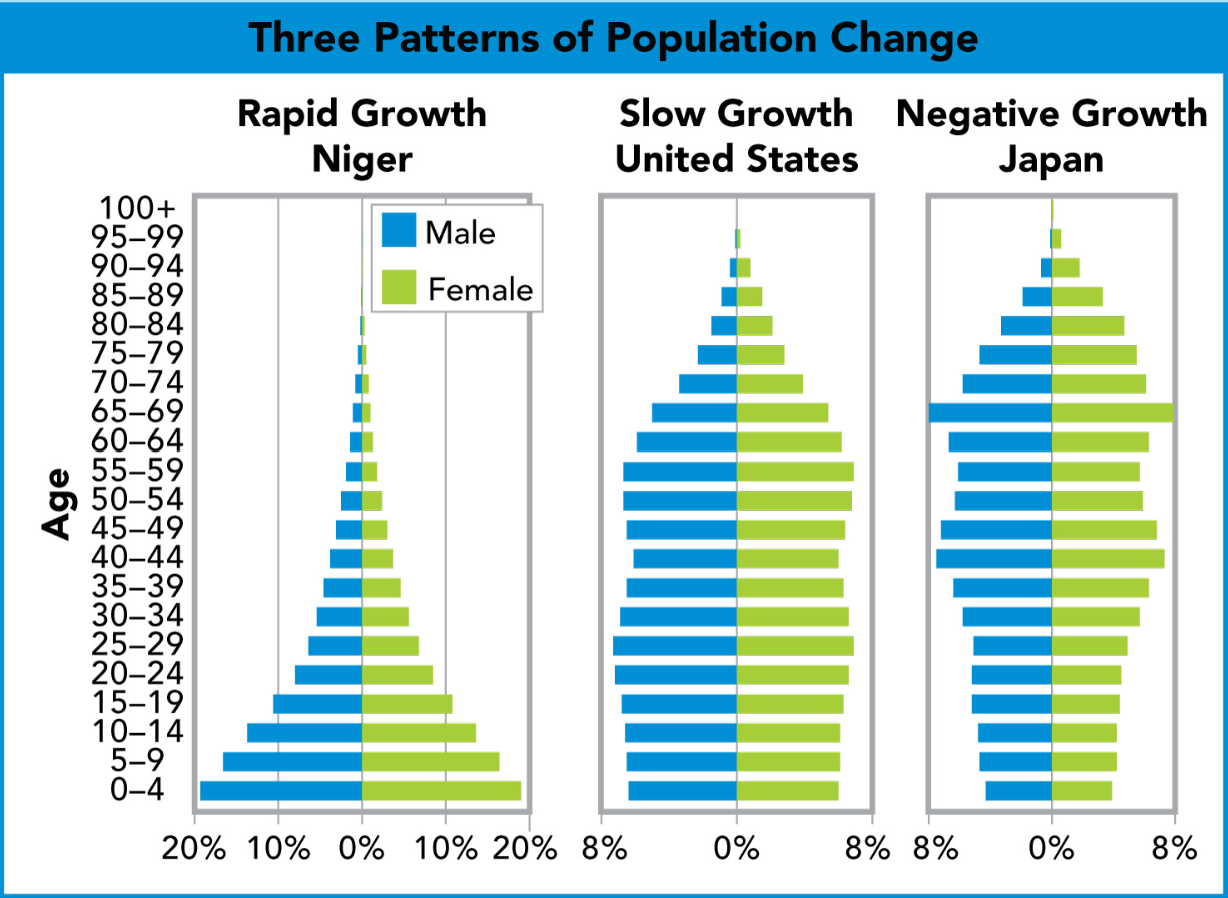
demographers consider many factors like deadly diseases (AIDS), malnutrition, and death rates to predict human population growth
Chapter 6 Lesson 1
within biomes, there are ecosystems, and within ecosystems, there are habitats
herbivore-plant relationships - herbivores affect the size and distribution of plant populations in a community and determine the places where certain plants can survive and grow
habitat - area where an organism lives including the biotic and abiotic factors that affect it
- an area with a particular combination of physical and biological environmental factors that affect which organisms can live within it
microhabitats/microenvironments - has their own set of environmental conditions called microclimate; small organisms live only in very small parts of larger habitats, including places like under leaves on a forest floor, under bark of a rotting log; usually exist within short distances of each other 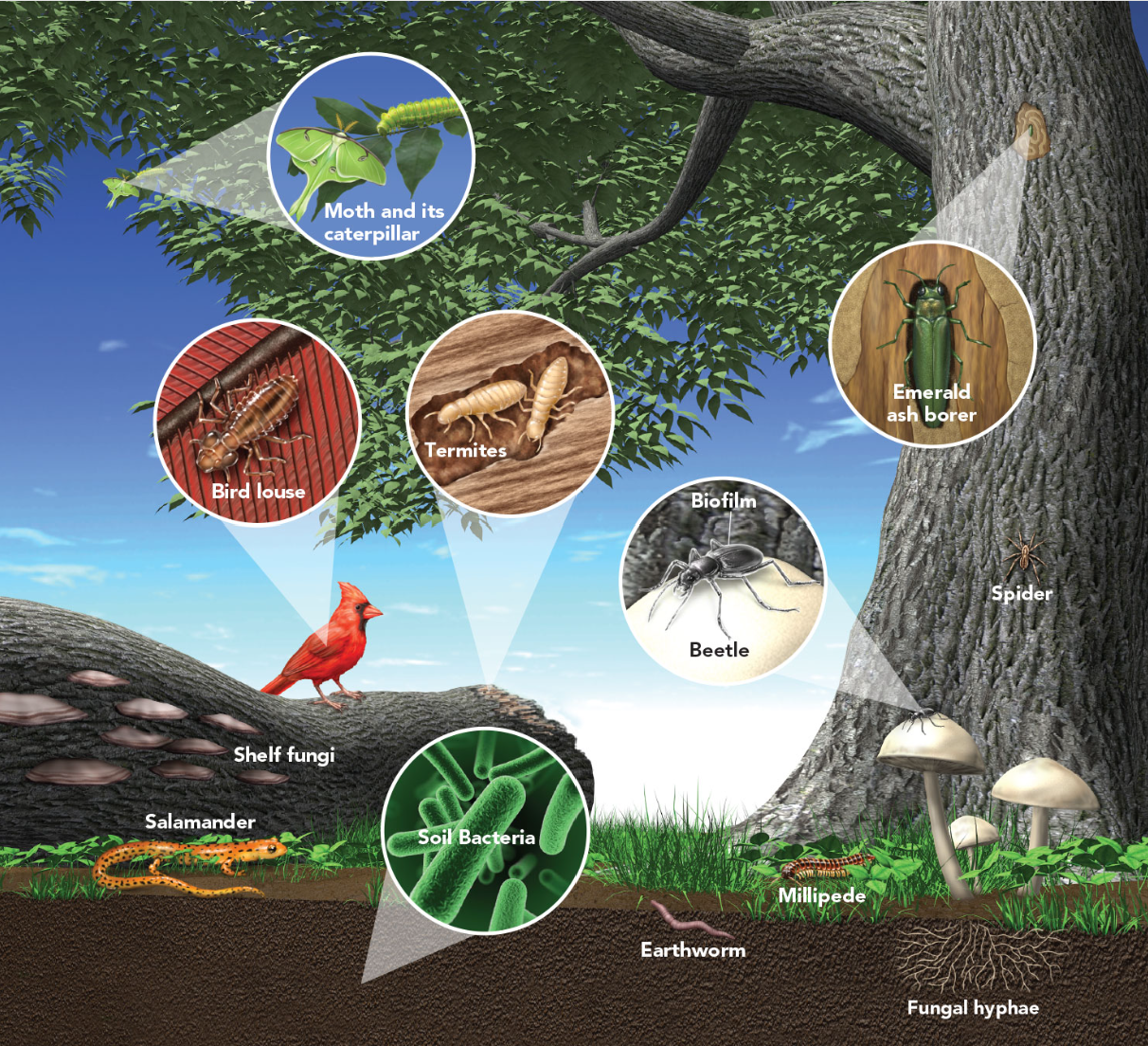
microbiomes - communities that inhabit places that weren’t considered “habitats” and perform important functions, including decomposing organic matter, soiling microbiomes, affecting plant health, the ability of roots to absorb water and nutrients, transfer carbon from plants to fungi (and from one plant to another), carry “messages” between plants, etc.; many ecological interactions are regulated by microbiomes
tolerance - ability of an organism to survive and reproduce under circumstances that differ from their optimal conditions
- variety of environmental conditions within which it can survive and reproduce
- within a species’ optimum range, environmental conditions enable individuals to find enough energy and nutrients to maintain homeostasis, grow, and reproduce
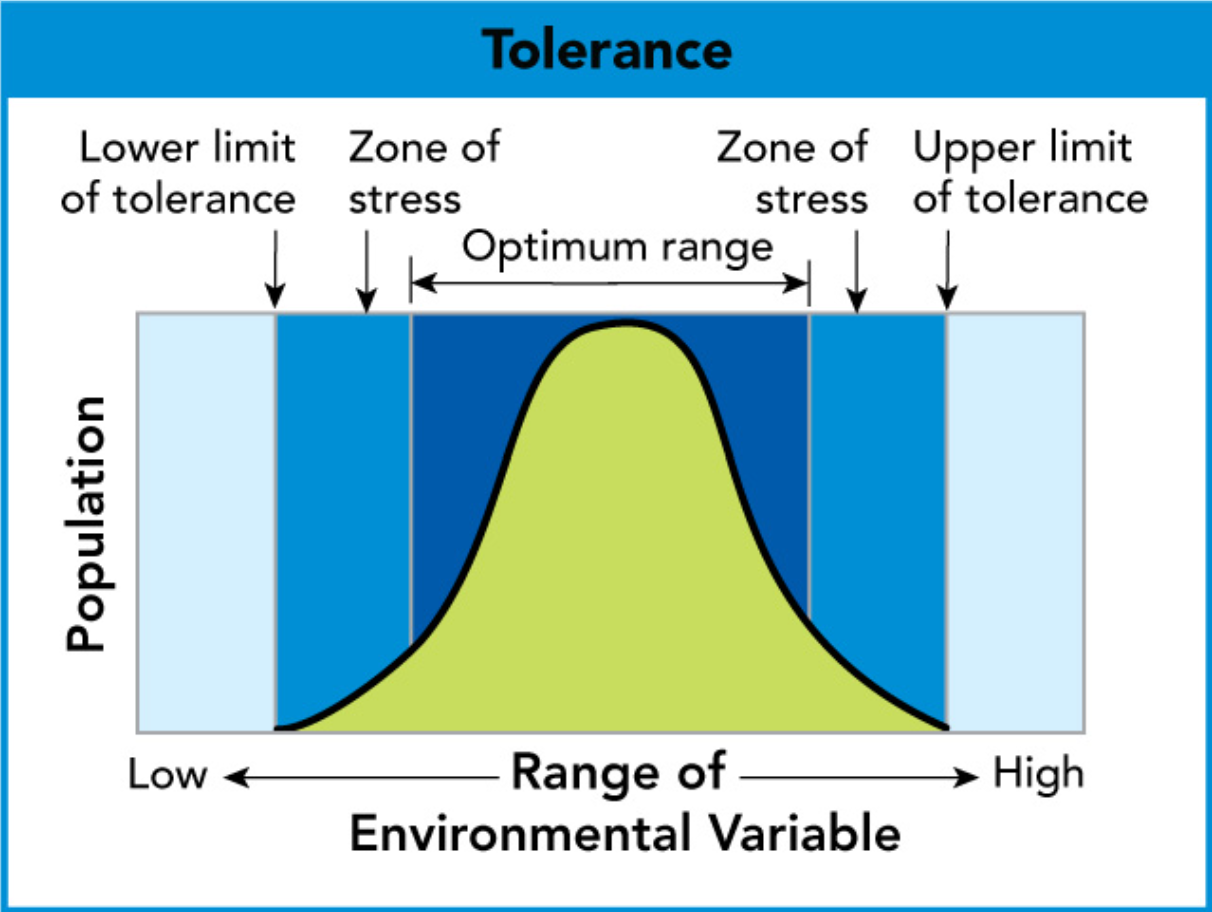
- if one or more environmental conditions (like temperature) rise above or fall below the optimum range, then organisms experience stress
- organisms under stress need more energy to maintain homeostasis, leaving less energy for growth and reproduction
- individuals can survive and reproduce under slightly stressful conditions, but typically would produce less offspring (even less offspring would survive)
- in more stressful conditions (beyond a species’ tolerance limits) organisms may survive but can’t reproduce (can’t survive)
niche - full range of physical and biological conditions in which an organism lives and the way in which the organism uses those conditions
- describes where an organism lives and its role in a habitat, including the way it interacts with biotic and abiotic factors
- a species’ niche includes the range of physical and biological conditions in which it can survive and reproduce, as well as the way it obtains resources it needs
resources and the niche - for plants, necessary resources include sunlight, water, and soil nutrients; for animals, resources can include nesting space, shelter, types of food, and places to feed
physical aspects of the niche - niche includes all the physical/abiotic factors to which it is adapted; ex. most amphibians absorb and lose water through their skin so they live in moist places, so if an area is too hot and dry for too long then most amphibians can’t survive; ex. plants like cacti can’t live in areas where their roots stay wet for too long
biological aspects of the niche - niche involves biological/biotic factors like the food it eats, the way it obtains that food, and when and how it reproduces; ex. communities of seabirds on a remote island may all nest in the same habitat but each species may prey on fish of different sizes and hunt in different places (each species occupies a distinct niche) 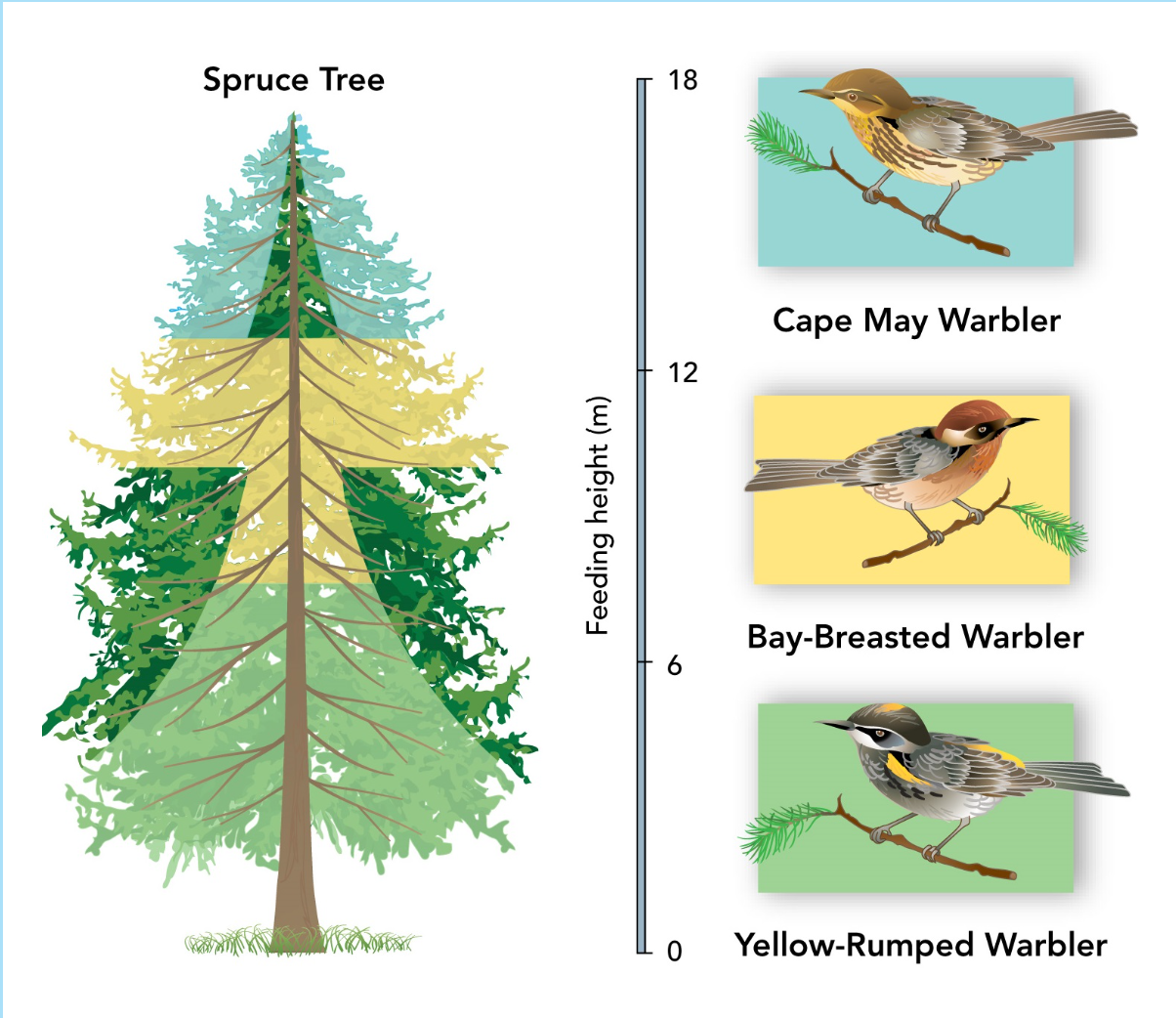
resource - any necessity of life, such as water, nutrients, light, food, or space
- refers to any necessity of life
competitive exclusion principle - principle that states that no two species can occupy the same niche in the same habitat at the same time
- if two species attempt to occupy the same niche, one species will be better at competing for limited resources and will eventually exclude the other species
competition - when more than one organism attempts to use the same limited ecological resource in the same place at the same time; ex. plant roots compete for water and nutrients in the soil, animals compete for food, mates, and places to live and raise offspring
intraspecific competition - competition among members of the same species
interspecific competition - competition between members of different species
direct competition between species usually produces a winner and loser (losing species dies out) 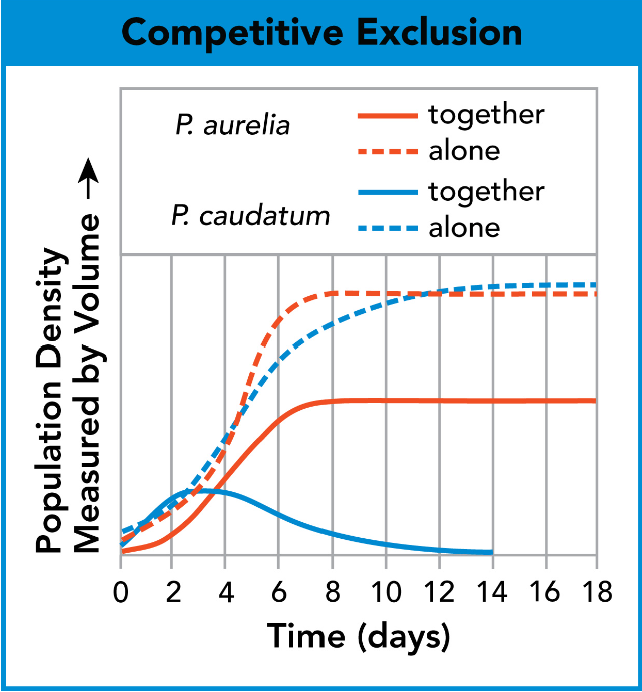
dividing resources - one species in a habitat occupying exactly the same niche happens because competition for resources creates pressure for each species to specialize in the way it obtains and uses resources; by causing species to divide resources, competition helps determine the numbers and kinds of species in a community and the niche each species occupies
bird diagram - birds all live in the same trees and feed on insects, but one species feeds on high branches, another feeds on low branches, and one feeds in the middle (resources are similar but not identical) so each species has its own niche; division of resources likely brought about by competition between the birds
keystone species - single species that is not usually abundant in a community yet exerts strong control on the structure of a community
plays a vital and unique role in maintaining structure, stability, and diversity in an ecosystem
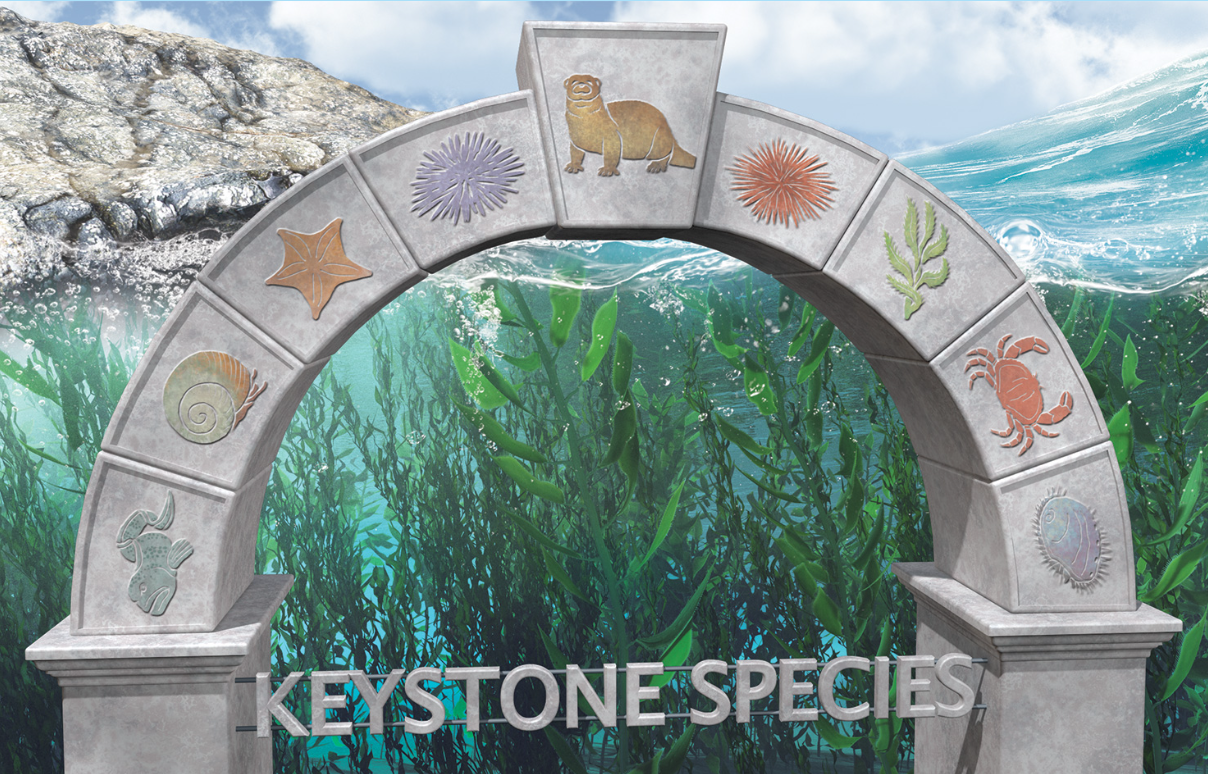
once an ecosystem has been changed by the removal of a keystone species, it may or may not be possible to restore the original community by simply putting the keystone species back
symbiosis - relationship in which two species live close together
- a particularly close, interdependent relationship between two species; means “living together”
- three main types are mutualism, commensalism, and parasitism
commensalism - symbiotic relationship in which one organism benefits and the other is neither helped nor harmed
- many members of microbiomes have commensal relationships with each other and with larger organisms
- ex. barnacles often attach to whales, barnacles benefit from the movement of water full of food particles past their swimming hosts
mutualism - symbiotic relationship in which both species benefit from the relationship
- very common in microbiomes (both soil and human)
- ex. sea anemones use stinging tentacles to protect themselves from predators and to capture prey, but certain fish manage to eat anemone tentacles; some anemone species have mutualistic partners (clownfish) which are immune to anemone stings, when clownfish are threatened they hide in anemone tentacles and when anemone are attacked then clownfish scare away the predators
parasitism - a symbiotic relationship in which one organism lives on or inside another organism and harms it
- parasite obtains all or part of its nutritional needs from the host organism
- usually weakens but doesn’t kill the host
Chapter 6 Lesson 2
why succession happens - happens in different environments usually because each species alters its environment in ways that make it easier for other species to compete for resources and survive; ex. lichen add organic matter and for soil, mosses and other small plants can colonize and grow, tree branches and leaves shade and protect the ground as well as provide shelter and food for animals; those processes increase the complexity of the environment which enables more plant and animal species to find homes and food, as well as increasing diversity
climax communities - succession in a given area would always proceed through the same stages to produce a specific, uniform, and stable community; but succession doesn’t always follow the same path, and climax communities aren’t always uniform and stable
succession after natural disturbances - when natural disturbances happen in healthy ecosystems, the events and processes that occur during secondary succession often, but not always, reproduce the original climax community; after disturbance is over, each patch undergoes succession so different patches within a larger community may be in a different stage of secondary succession at the same time; some climax communities are disturbed so often that they look like ecological “patchwork quilts” and can’t be either uniform or stable
succession after human-caused disturbances - land cleared for farming and then abandoned often passes through succession that eventually produces a community that may or may not resemble the original climax community (ecosystems may or may not recover from extensive human-caused disturbances); secondary succession can take different paths, and produce different communities, depending on the kind of distrubance, the season in which the disturbance occurs, and other factors; ex. clearing and farming of tropical rain forests can change the physical structure of soil and the soil microbiome in ways that prevent regrowth of the original community
studying patterns of succession - ecologists study succession by comparing different cases and looking for similarities and differences; in one example, primary succession proceeded through stages--pioneer species arrived via seeds, spores, or adult stages that traveled over long distances; pioneer species are important because they help stabilize loose volcanic debris, allowing later species to take hold; early stages of primary succession are slow, and chance can play a large role in determining which species colonize at different times
ecological succession - series of gradual changes that occur in a community following a disturbance
- a series of somewhat predictable events that occur in a community over time
- ecosystems change over time, especially after disturbances, as new species move in, populations change, and some species die out
- species diversity typically increases over the course of succession
primary succession - succession that occurs in an area in which no trace of a previous community is present
begins on newly formed rock
volcanic explosions can create new land or sterilize existing areas
retreating glaciers can have the same effect where they leave only exposed bare rock behind them
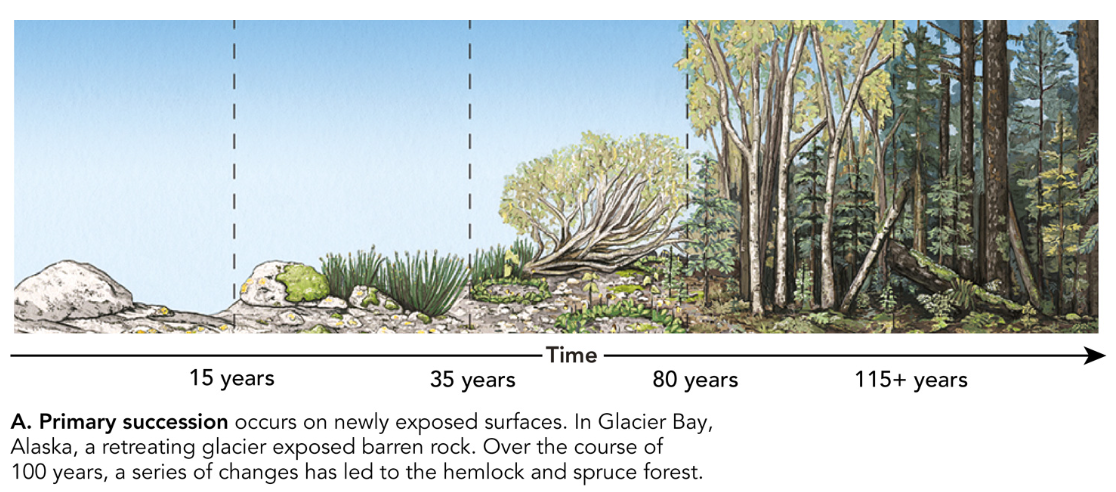
pioneer species - first species to populate an area during succession
- first species to colonize barren areas
- similar to human pioneers, creating the first settlements and doing ground breaking work that makes an area habitable for subsequent settlers
- have broad ranges of tolerance for environmental factors (how they manage to survive on bare rock or in soil that lacks nutrients and a mature microbiome)
- ecological pioneer - lichen: a symbiosis between a multicellular fungus, a yeast, and a photosynthetic organism; mosses and certain grasses
- pioneer species break down rock, synthesize organic material, and begin to form soil
secondary succession - type of succession that occurs in an area that was only partially destroyed by disturbances
proceeds faster than primary succession partially because bits of the old community survive and can regrow rapidly
happens on land after a wildfire, hurricane, or another natural disturbance
- many species adapted to them
- ex. forest fires kill some trees, others are left alone and fire helps germinate their seeds
also happens after logging and farming (human activities)
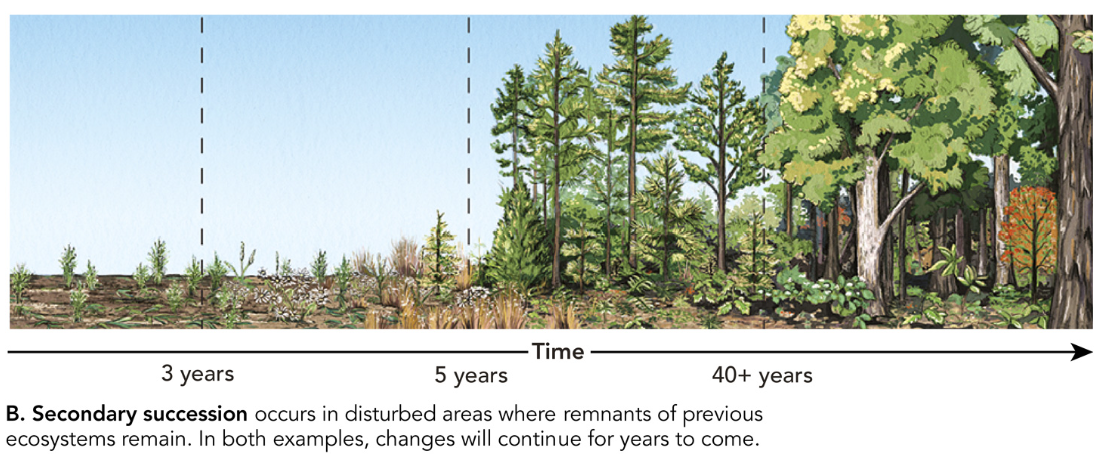
Chapter 6 Lesson 3
- biodiversity benefits - include offering invaluable contributions to medicine and agriculture, and enabling organisms and ecosystems to adapt to environmental change
- biodiversity and medicine - medicines like painkillers (aspirin) and antibiotics (penicillin) were first discovered in wild species; other plant compounds from wild species are used to treat diseases like depression and cancer
- biodiversity and agriculture - most crop plants have wild relatives which may carry genes that promote disease resistance, pest resistance, or other useful traits that could be transferred to crop plants through plant breeding or genetic engineering
- biodiversity and ecosystem resilience - biological diversity can affect an ecosystem’s structure, stability, and function; keystone species increase community biodiversity while the removal decreases biodiversity and stability; a decrease in an ecosystem’s species diversity can affect its resilience
human society depends on healthy ecosystems in multiple ways
biodiversity - the total of the variety of organisms in the biosphere; also called biological diversity
- the variety and variability of animals, plants, and microorganisms, including ecosystem diversity, species diversity, and genetic diversity
ecosystem diversity - variety of habitats, communities, and ecological processes in the biosphere
- refers to the variety of habitats, communities, and ecological processes in the biosphere
species diversity - number of different species that makes up a particular area
- the number of different species in the biosphere, or in a particular area
- biologists have identified and named more than 1.2 million eukaryotic species (and estimate at least 9 million more to be discovered, not including microbiomes)
- a lot more diversity exists among single-celled organisms
genetic diversity - sum total of all the different forms of genetic information carried by a particular species, or by all organisms on Earth
- refers to the total of all different forms of genes present in a particular species
- can be invisible, but is responsible for within-species variations among organisms, both in individual ecosystems and among different ecosystems
- is the raw material that enables organisms to adapt to changing external factors
resilience - the ability to recover after a disturbance; the ability to deal with change and move on
a natural or human system’s ability to recover after a disturbance
resilient ecosystems have some ability to adapt over time to changes in their surroundings
the more species that are present in an ecosystem, the more likely that some species have different tolerance ranges for environmental conditions (temperature and rainfall)
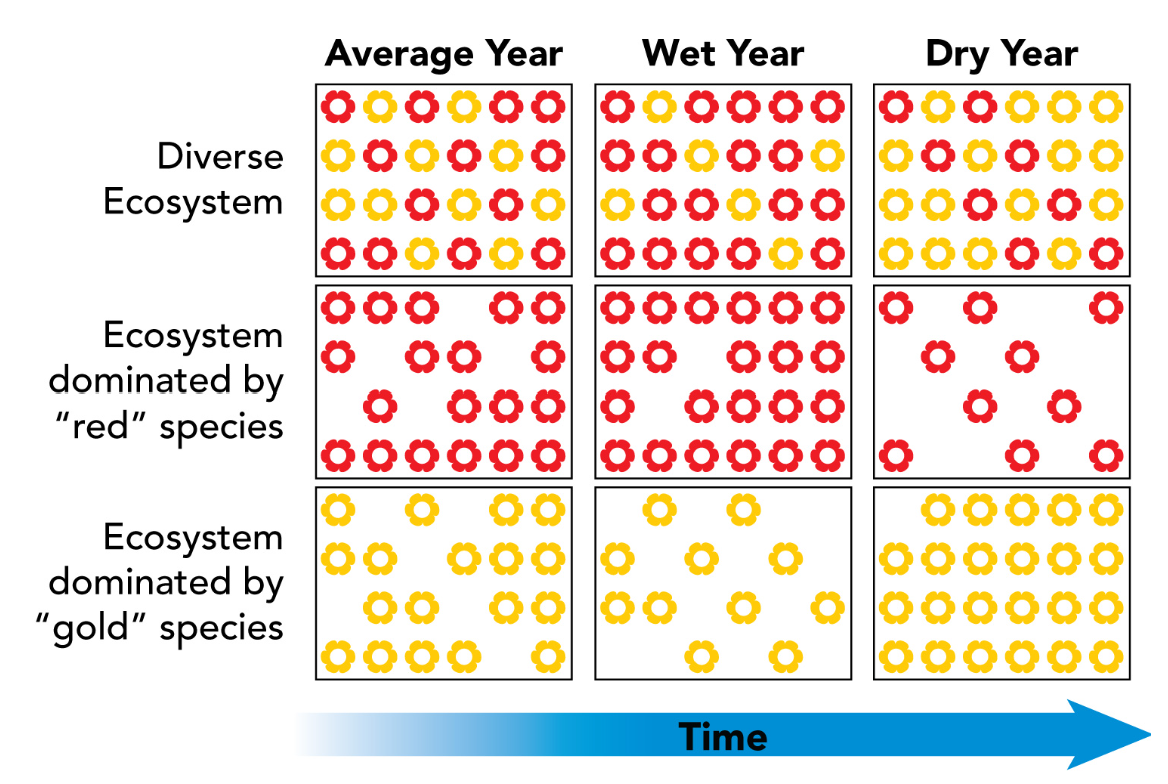
ecosystem services - the benefits for humans that are provided by healthy ecosystems
important ecosystem services include producing food, cycling nutrients, purifying water, storing carbon, regulating pests, pollinating crops, and buffering the effects of extreme weather events
- food production - diverse ecosystems, such as prairies, can provide a resilient mix of food for livestock; wild species can preserve genes that may improve related crops or livestock
- nutrient cycling and soil structure - both carbon and nitrogen cycles depend, in part, on the activities of the soil microbiome; a resilient soil microbiome helps maintain soil fertility and structure under changing conditions
- purifying water - soil microbiomes, along with algae and plants, play vital roles in filtering and purifying fresh water
- storing carbon - healthy and actively growing terrestrial and marine ecosystems with high primary productivity remove carbon dioxide from the atmosphere and store the carbon; biodiverse ecosystems are generally more resilient and can provide this function under a wider range of environmental conditions
- regulating pests and pollinating crops - biologically diverse and resilient ecosystems include predators that feed on herbivores that might attack crop plants; diverse terrestrial ecosystems offer food and shelter to vital pollinating insects
- buffering effects of extreme weather events - diverse and resilient coastal wetlands protect against erosion and shield shorelines against storms; forests can protect mountainsides against erosion and landslides
